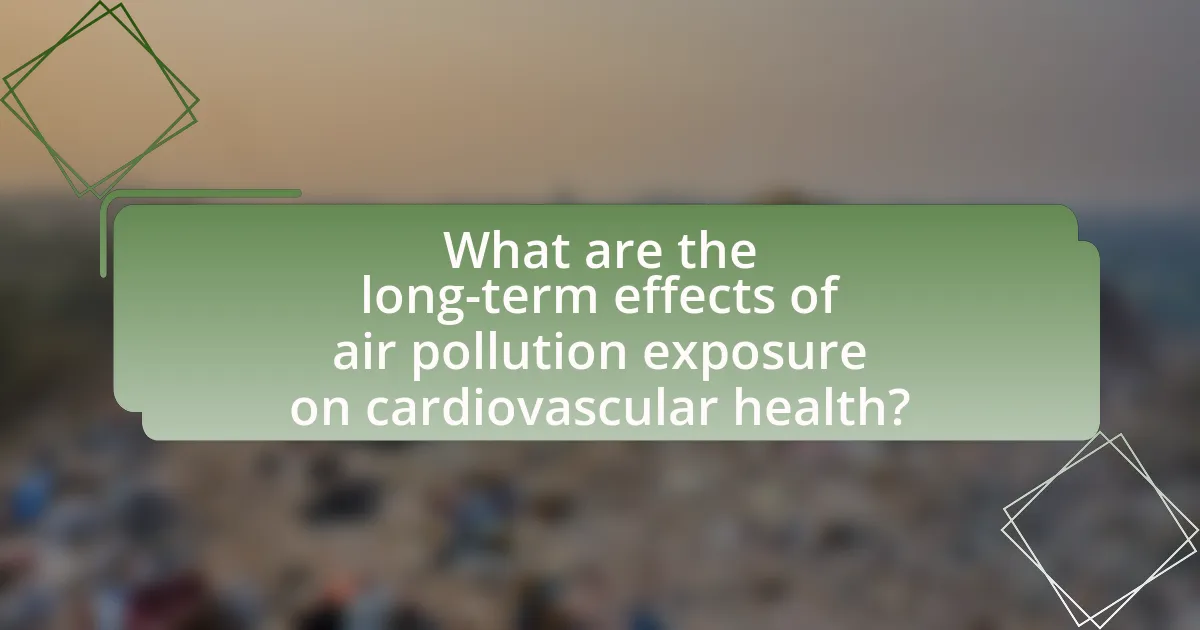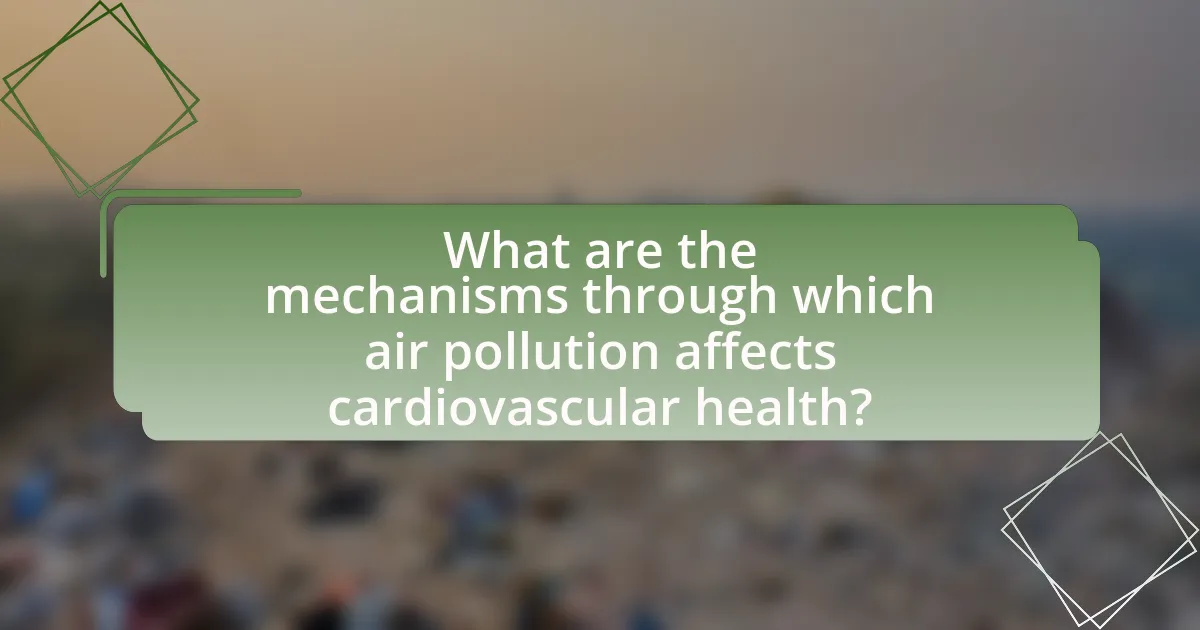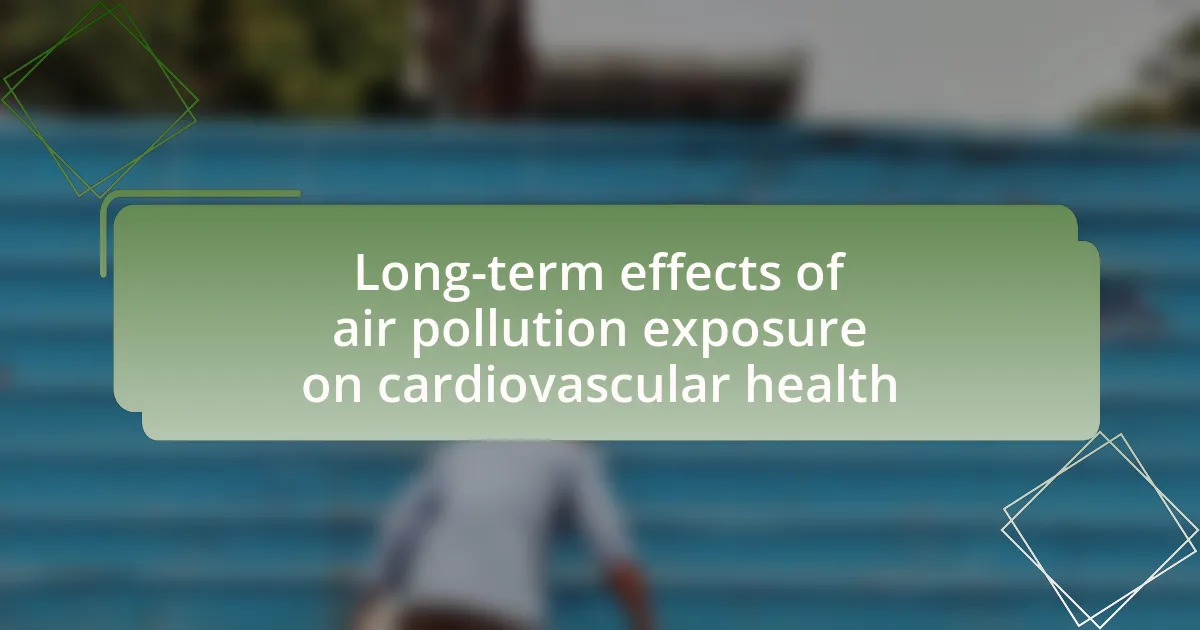Long-term exposure to air pollution is a significant risk factor for cardiovascular health, leading to increased rates of heart attacks, strokes, and hypertension. Key pollutants such as fine particulate matter (PM2.5), nitrogen dioxide (NO2), and sulfur dioxide (SO2) contribute to systemic inflammation, oxidative stress, and endothelial dysfunction, which are critical in the development of cardiovascular diseases. Vulnerable populations, including children, the elderly, and low-income communities, face heightened risks due to socioeconomic factors and pre-existing health conditions. Understanding these impacts is essential for implementing effective public health policies and interventions aimed at reducing air pollution and improving cardiovascular outcomes.
What are the long-term effects of air pollution exposure on cardiovascular health?

Long-term exposure to air pollution significantly increases the risk of cardiovascular diseases, including heart attacks, strokes, and hypertension. Studies have shown that fine particulate matter (PM2.5) and other pollutants can lead to systemic inflammation, endothelial dysfunction, and atherosclerosis, which are critical factors in the development of cardiovascular conditions. For instance, research published in the Journal of the American College of Cardiology indicates that long-term exposure to PM2.5 is associated with a 20% increase in the risk of coronary heart disease. Additionally, the World Health Organization has reported that air pollution contributes to approximately 7 million premature deaths annually, with a substantial portion attributed to cardiovascular diseases.
How does air pollution contribute to cardiovascular diseases?
Air pollution contributes to cardiovascular diseases primarily through the inhalation of fine particulate matter and toxic gases, which can lead to systemic inflammation and oxidative stress. These pollutants enter the bloodstream, causing endothelial dysfunction, increased blood pressure, and promoting atherosclerosis. Studies have shown that long-term exposure to air pollution is associated with a significant increase in the risk of heart attacks and strokes, with research indicating that a 10 µg/m³ increase in PM2.5 is linked to a 12% increase in cardiovascular mortality.
What specific pollutants are most harmful to cardiovascular health?
Particulate matter (PM), nitrogen dioxide (NO2), and sulfur dioxide (SO2) are the specific pollutants most harmful to cardiovascular health. Research indicates that exposure to fine particulate matter (PM2.5) can lead to increased rates of heart attacks, strokes, and other cardiovascular diseases. A study published in the Journal of the American College of Cardiology found that long-term exposure to PM2.5 is associated with a 20% increase in cardiovascular mortality. Additionally, nitrogen dioxide, primarily from vehicle emissions, has been linked to inflammation and arterial damage, further exacerbating cardiovascular risks. Sulfur dioxide, often produced by industrial processes, can also contribute to respiratory and cardiovascular issues, as evidenced by findings from the American Heart Association, which highlight its role in increasing hospital admissions for heart-related conditions.
How do these pollutants interact with the cardiovascular system?
Pollutants interact with the cardiovascular system primarily by inducing inflammation, oxidative stress, and endothelial dysfunction. These interactions lead to increased blood pressure, arterial stiffness, and a higher risk of atherosclerosis. Studies have shown that fine particulate matter (PM2.5) and nitrogen dioxide (NO2) can penetrate the bloodstream, triggering systemic inflammatory responses and contributing to cardiovascular diseases. For instance, research published in the Journal of the American College of Cardiology indicates that long-term exposure to air pollution is associated with a significant increase in cardiovascular morbidity and mortality, highlighting the detrimental effects of these pollutants on heart health.
Why is it important to study the long-term effects of air pollution?
Studying the long-term effects of air pollution is crucial because it directly impacts public health, particularly cardiovascular health. Research indicates that prolonged exposure to air pollutants, such as particulate matter and nitrogen dioxide, is linked to increased risks of heart disease, stroke, and other cardiovascular conditions. For instance, a study published in the Journal of the American Heart Association found that long-term exposure to fine particulate matter is associated with a 20% increase in the risk of cardiovascular mortality. Understanding these effects enables policymakers to implement effective regulations and public health interventions to mitigate risks and improve community health outcomes.
What trends have been observed in cardiovascular health related to air pollution exposure?
Trends in cardiovascular health related to air pollution exposure indicate a significant increase in the incidence of cardiovascular diseases among populations living in areas with high pollution levels. Research has shown that long-term exposure to particulate matter, nitrogen dioxide, and other pollutants correlates with higher rates of hypertension, heart attacks, and strokes. For instance, a study published in the Journal of the American College of Cardiology found that individuals exposed to elevated levels of air pollution had a 20% increased risk of developing heart disease compared to those in cleaner environments. Additionally, the World Health Organization reports that air pollution is responsible for approximately 4.2 million premature deaths globally each year, with cardiovascular diseases being a leading cause. These findings underscore the detrimental impact of air pollution on cardiovascular health, highlighting a clear trend of worsening health outcomes in polluted areas.
How do socioeconomic factors influence the impact of air pollution on cardiovascular health?
Socioeconomic factors significantly influence the impact of air pollution on cardiovascular health by determining exposure levels, access to healthcare, and overall health resilience. Individuals in lower socioeconomic groups often live in areas with higher pollution levels due to industrial activities and traffic, leading to increased cardiovascular risks. For instance, studies have shown that populations with lower income and education levels experience higher rates of heart disease linked to air pollution exposure, as they may lack resources to mitigate these effects, such as living in cleaner environments or accessing preventive healthcare. Additionally, socioeconomic status affects lifestyle choices, stress levels, and pre-existing health conditions, further exacerbating the adverse effects of air pollution on cardiovascular health.
What populations are most at risk from air pollution exposure?

Populations most at risk from air pollution exposure include children, the elderly, individuals with pre-existing health conditions, and low-income communities. Children are particularly vulnerable due to their developing respiratory systems and higher rates of outdoor activity, which increases their exposure. The elderly often have weakened immune systems and pre-existing cardiovascular or respiratory conditions that can be exacerbated by poor air quality. Individuals with pre-existing health conditions, such as asthma or heart disease, face heightened risks as air pollution can trigger or worsen these ailments. Low-income communities frequently reside in areas with higher pollution levels and may lack access to healthcare resources, making them more susceptible to the adverse effects of air pollution. Studies have shown that these groups experience higher rates of respiratory and cardiovascular diseases linked to air pollution exposure, underscoring their increased vulnerability.
How does age affect vulnerability to cardiovascular issues from air pollution?
Age significantly affects vulnerability to cardiovascular issues from air pollution, with older adults being at greater risk. This increased vulnerability is due to age-related physiological changes, such as reduced lung function, increased arterial stiffness, and a higher prevalence of pre-existing health conditions like hypertension and diabetes. Research indicates that individuals over 65 years are more likely to experience adverse cardiovascular effects from air pollution exposure, as evidenced by a study published in the Journal of the American Heart Association, which found that long-term exposure to fine particulate matter (PM2.5) is associated with a 20% increase in cardiovascular mortality among older adults compared to younger populations.
What role does pre-existing health conditions play in this vulnerability?
Pre-existing health conditions significantly increase vulnerability to the long-term effects of air pollution on cardiovascular health. Individuals with conditions such as hypertension, diabetes, or pre-existing heart disease are more susceptible to adverse outcomes from air pollution exposure, as these conditions can exacerbate the inflammatory responses and oxidative stress caused by pollutants. Research indicates that people with cardiovascular diseases have a higher risk of hospitalization and mortality when exposed to elevated levels of air pollution, as demonstrated in studies published in journals like Environmental Health Perspectives, which highlight the correlation between air quality and cardiovascular events in at-risk populations.
Are certain demographics more affected by air pollution than others?
Certain demographics are indeed more affected by air pollution than others, particularly children, the elderly, and individuals with pre-existing health conditions. Research indicates that children are more vulnerable due to their developing respiratory systems, while older adults often have weakened immune responses and existing cardiovascular issues that can be exacerbated by poor air quality. A study published in the journal “Environmental Health Perspectives” found that low-income communities and racial minorities are disproportionately exposed to higher levels of air pollution, leading to increased rates of cardiovascular diseases in these populations. This evidence underscores the significant impact of demographic factors on the health effects of air pollution.
What geographical areas are most impacted by air pollution-related cardiovascular health issues?
Urban areas with high population density and industrial activity, such as Beijing, Delhi, and Los Angeles, are most impacted by air pollution-related cardiovascular health issues. These cities experience elevated levels of particulate matter and other pollutants, which have been linked to increased rates of heart disease and stroke. For instance, a study published in the Journal of the American College of Cardiology found that long-term exposure to fine particulate matter (PM2.5) significantly raises the risk of cardiovascular mortality, particularly in densely populated regions.
How do urban environments compare to rural areas in terms of cardiovascular risks?
Urban environments generally present higher cardiovascular risks compared to rural areas. This increased risk is primarily attributed to elevated levels of air pollution, which are more prevalent in urban settings. Studies indicate that long-term exposure to pollutants such as particulate matter and nitrogen dioxide is linked to higher incidences of heart disease and hypertension. For instance, research published in the Journal of the American College of Cardiology found that individuals living in areas with high air pollution had a 20% greater risk of developing cardiovascular diseases compared to those in cleaner, rural environments.
What measures are being taken in high-risk areas to mitigate these effects?
In high-risk areas, measures being taken to mitigate the long-term effects of air pollution exposure on cardiovascular health include implementing stricter air quality regulations, enhancing public transportation systems, and promoting green spaces. Stricter regulations, such as the enforcement of the National Ambient Air Quality Standards, aim to reduce emissions from industrial sources and vehicles, thereby improving overall air quality. Enhanced public transportation systems encourage the use of cleaner transit options, reducing reliance on personal vehicles and lowering emissions. Additionally, promoting green spaces, such as parks and urban forests, helps to improve air quality and provides health benefits by encouraging physical activity. These measures are supported by studies indicating that improved air quality can lead to significant reductions in cardiovascular disease incidence and mortality rates.
What are the mechanisms through which air pollution affects cardiovascular health?

Air pollution affects cardiovascular health primarily through mechanisms such as inflammation, oxidative stress, and endothelial dysfunction. Inhaled particulate matter and gases can enter the bloodstream, triggering inflammatory responses that lead to the release of pro-inflammatory cytokines. This inflammation contributes to the development of atherosclerosis, a condition characterized by the buildup of plaques in the arteries.
Additionally, air pollutants generate reactive oxygen species, which cause oxidative stress, damaging endothelial cells and impairing their function. This dysfunction can result in increased vascular permeability and reduced nitric oxide availability, further exacerbating cardiovascular issues. Studies have shown that long-term exposure to air pollution is associated with increased rates of heart attacks, strokes, and other cardiovascular diseases, highlighting the significant impact of these mechanisms on overall heart health.
How does inflammation relate to cardiovascular diseases caused by air pollution?
Inflammation is a key mechanism linking air pollution to cardiovascular diseases. Exposure to air pollutants, such as particulate matter and nitrogen dioxide, triggers an inflammatory response in the body, which can lead to endothelial dysfunction, a precursor to cardiovascular issues. Studies have shown that chronic exposure to air pollution increases levels of inflammatory markers like C-reactive protein and interleukin-6, which are associated with a higher risk of heart disease. For instance, research published in the Journal of the American College of Cardiology found that long-term exposure to fine particulate matter significantly correlates with increased systemic inflammation and subsequent cardiovascular morbidity and mortality.
What biological processes are triggered by air pollution exposure?
Air pollution exposure triggers several biological processes, including oxidative stress, inflammation, and endothelial dysfunction. Oxidative stress occurs when pollutants generate reactive oxygen species, leading to cellular damage. Inflammation is activated as the immune system responds to inhaled particulate matter and gases, resulting in the release of pro-inflammatory cytokines. Endothelial dysfunction arises from the impairment of the endothelium’s ability to regulate blood flow and maintain vascular health, which is linked to increased cardiovascular disease risk. These processes are supported by studies showing that long-term exposure to air pollutants correlates with elevated markers of inflammation and oxidative stress in individuals, contributing to adverse cardiovascular outcomes.
How does oxidative stress contribute to cardiovascular damage?
Oxidative stress contributes to cardiovascular damage by promoting inflammation and endothelial dysfunction. This occurs when there is an imbalance between reactive oxygen species (ROS) production and the body’s antioxidant defenses, leading to cellular damage. Elevated levels of ROS can oxidize lipids, proteins, and DNA, which disrupts normal cellular function and promotes atherosclerosis. Studies have shown that oxidative stress is linked to increased levels of inflammatory markers, such as C-reactive protein, which further exacerbate cardiovascular conditions. Additionally, oxidative stress impairs nitric oxide availability, crucial for vascular relaxation, thereby increasing blood pressure and contributing to heart disease.
What role does particulate matter play in cardiovascular health?
Particulate matter significantly contributes to cardiovascular health issues by increasing the risk of heart disease and stroke. Studies have shown that exposure to fine particulate matter (PM2.5) can lead to inflammation, oxidative stress, and endothelial dysfunction, which are critical factors in the development of atherosclerosis. For instance, research published in the Journal of the American College of Cardiology indicates that long-term exposure to PM2.5 is associated with a 20% increase in the risk of cardiovascular mortality. Additionally, the World Health Organization has classified air pollution, including particulate matter, as a leading environmental risk factor for cardiovascular diseases, highlighting its detrimental impact on heart health.
What are the different types of particulate matter and their effects?
Particulate matter (PM) is categorized into several types based on size, primarily PM10, PM2.5, and ultrafine particles (UFPs). PM10 includes particles with a diameter of 10 micrometers or smaller, which can penetrate the respiratory system and cause respiratory issues. PM2.5 consists of finer particles with a diameter of 2.5 micrometers or smaller, known to penetrate deep into the lungs and enter the bloodstream, leading to cardiovascular diseases, including heart attacks and strokes. Ultrafine particles, smaller than 0.1 micrometers, can reach systemic circulation and have been linked to adverse cardiovascular effects, such as increased blood pressure and inflammation. Studies indicate that long-term exposure to these types of particulate matter significantly elevates the risk of developing cardiovascular conditions, highlighting the importance of air quality management for public health.
How does long-term exposure to particulate matter lead to chronic conditions?
Long-term exposure to particulate matter leads to chronic conditions primarily by causing systemic inflammation and oxidative stress in the body. These fine particles can penetrate deep into the lungs and enter the bloodstream, triggering inflammatory responses that can damage blood vessels and heart tissues. Research indicates that individuals exposed to high levels of particulate matter are at an increased risk of developing cardiovascular diseases, such as hypertension and atherosclerosis. A study published in the Journal of the American Heart Association found that long-term exposure to fine particulate matter is associated with a 20% increase in the risk of heart attacks and strokes. This evidence underscores the direct link between particulate matter exposure and the development of chronic cardiovascular conditions.
What strategies can be implemented to reduce the impact of air pollution on cardiovascular health?
To reduce the impact of air pollution on cardiovascular health, implementing strategies such as improving air quality regulations, promoting the use of public transportation, and increasing green spaces in urban areas is essential. Improved air quality regulations can limit emissions from industrial sources and vehicles, thereby decreasing the concentration of harmful pollutants like particulate matter and nitrogen dioxide, which are linked to cardiovascular diseases. Promoting public transportation reduces the number of vehicles on the road, leading to lower emissions and improved air quality. Additionally, increasing green spaces can enhance air filtration and provide residents with healthier environments, which has been shown to correlate with lower rates of cardiovascular issues. Studies indicate that areas with more vegetation experience reduced air pollution levels, contributing to better cardiovascular health outcomes.
What lifestyle changes can individuals make to protect their cardiovascular health?
Individuals can protect their cardiovascular health by adopting a balanced diet, engaging in regular physical activity, maintaining a healthy weight, avoiding tobacco use, and managing stress effectively. A balanced diet rich in fruits, vegetables, whole grains, and lean proteins can lower cholesterol levels and reduce blood pressure, which are critical for heart health. Regular physical activity, such as 150 minutes of moderate aerobic exercise weekly, strengthens the heart and improves circulation. Maintaining a healthy weight reduces the risk of heart disease, as obesity is a significant risk factor. Avoiding tobacco use is crucial, as smoking is linked to increased cardiovascular disease risk. Lastly, effective stress management techniques, such as mindfulness and relaxation exercises, can lower heart rate and blood pressure, contributing to overall cardiovascular health.
How can public policy and community initiatives help mitigate air pollution effects?
Public policy and community initiatives can significantly mitigate air pollution effects by implementing regulations that limit emissions and promoting public awareness campaigns. For instance, policies such as the Clean Air Act in the United States have led to a substantial reduction in air pollutants, resulting in improved cardiovascular health outcomes. Studies indicate that areas with stricter air quality regulations experience lower rates of heart disease and related conditions. Community initiatives, such as tree planting programs and the promotion of public transportation, further enhance air quality by reducing vehicle emissions and increasing green spaces, which can absorb pollutants. These combined efforts create a healthier environment, directly impacting long-term cardiovascular health positively.

Leave a Reply